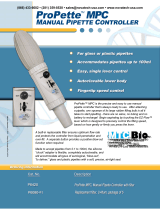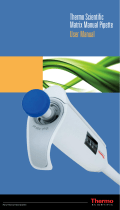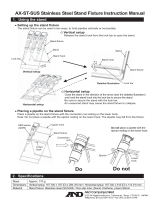
Page 3
Introduction
This document contains Decontamination Procedures suitable for
Pipetman® P, Pipetman® F, Pipetman® Ultra (Single and Multichannel),
Pipetman® 8X200, Microman® and Distriman®; it describes how to
decontaminate specific component parts of these pipettes.
Only after preliminary checks for radioactivity may the pipette be
unpacked and disassembled for subsequent cleaning and decontami-
nation, using disposable gloves.
DD
DD
D
ecec
ecec
ec
onon
onon
on
taminatamina
taminatamina
tamina
tion startion star
tion startion star
tion star
ts with rts with r
ts with rts with r
ts with r
adioacadioac
adioacadioac
adioac
tivittivit
tivittivit
tivit
y checksy checks
y checksy checks
y checks using a
validated Geiger-Müller counter equipped with probes capable of
detecting gamma, beta and X-rays. Cleaning is integrated in the
combined chemical and biological Decontamination Procedure.
Complete servicing consists of three mandatory procedures, to be
performed in the following order: decontamination, maintenance [see
respective Maintenance Procedure*] and calibration [see respective
Adjustment Procedure*].
Parts that are found to have been damaged or to have been attacked
chemically must be replaced with new ones before reassembling the
pipette. Any parts that you remove from the pipette because they
suffered chemical or mechanical damage should be decontaminated
before being discarded.
DD
DD
D
ecec
ecec
ec
onon
onon
on
taminatamina
taminatamina
tamina
tion Rtion R
tion Rtion R
tion R
oomoom
oomoom
oom
The decontamination room must be separate from all other rooms in
the laboratory. For safety reasons, only authorized personnel should
be allowed to enter the decontamination room.
EE
EE
E
quipmenquipmen
quipmenquipmen
quipmen
t and Clothingt and Clothing
t and Clothingt and Clothing
t and Clothing
1) Protective clothing, safety glasses, and disposable gloves.
2) Geiger-Müller counter for detecting beta, gamma and X-rays.
3) Benches, one equipped with a safety hood (without filter).
4) Disposable bench covers and safety bags.
5) A safety box (e.g. a lead box).
6) A separate identifiable plastic box for each pipette.
7) For the manual method, small round brushes for cleaning the in-
sides of the tip-holders.
8) For the alternative immersion method: an ultrasonic bath, lattice
boxes and lattice container, plus a thermostatically controlled oven
(50 °C to 60 °C).
End-users mEnd-users m
End-users mEnd-users m
End-users m
ust decust dec
ust decust dec
ust dec
on-on-
on-on-
on-
taminattaminat
taminattaminat
taminat
e their pipe their pip
e their pipe their pip
e their pip
ettett
ettett
ett
eses
eses
es
beforbefor
beforbefor
befor
e sending them te sending them t
e sending them te sending them t
e sending them t
oo
oo
o
their loctheir loc
their loctheir loc
their loc
al Gilson Sal Gilson S
al Gilson Sal Gilson S
al Gilson S
erer
erer
er
vicvic
vicvic
vic
ee
ee
e
CC
CC
C
entent
entent
ent
erer
erer
er
..
..
.
* To be carried out by suitably quali-
fied people only. End-users should
refer to their local distributor for fur-
ther information.
Damaged parts: contact your local
Gilson distributor, who will either
supply you with genuine Gilson user-
level replacements parts or who will
service the pipette for you.

















